#Bridge Rectifier Module
Explore tagged Tumblr posts
Text
Semikron SKD160-16 Bridge Rectifier Diode: High-Power Solution for Industrial Applications
For more information or to purchase the SKD160-16, visit the official website of Semikron distributor https://www.uscomponent.com/buy/Semikron/SKD160-16.
With its combination of high surge current capability, rugged design, and high efficiency, the Semikron SKD160-16 Bridge Rectifier Diode offers reliable performance in even the most demanding industrial environments. Its compact yet durable package ensures it can withstand harsh conditions while delivering consistent and efficient power conversion.
By choosing the Semikron SKD160-16, you benefit from a trusted solution for high-power applications that demand efficiency, reliability, and durability.
SKD160-16 is a high-power Bridge Rectifier Diode produced by Semikron, a leading manufacturer of power electronics components. It is designed for use in high-current applications and is widely used in power supplies and industrial automation systems.
The SKD160-16 Bridge Rectifier Diode is a four-terminal device consisting of four diodes that are arranged in a bridge configuration. This configuration allows for the conversion of an alternating current (AC) input signal to a direct current (DC) output signal.
The diode has a maximum current rating of 160A and a maximum voltage rating of 1600V, making it suitable for high-power applications. It is also designed with a high surge current capability, which enables it to handle brief overloads without damage.
The SKD160-16 Bridge Rectifier Diode is designed with low forward voltage drop and low reverse recovery time, which results in low power dissipation and high efficiency. It is also designed with a rugged and reliable package, which provides excellent thermal performance and high resistance to mechanical stress.
Overall, the SKD160-16 Bridge Rectifier Diode is a high-performance device that provides efficient and reliable power conversion capabilities in high-power applications. Its rugged design and high surge current capability make it suitable for use in harsh environments and industrial applications that require high reliability and durability.
#Diode#Bridge Rectifier#Transistor#Full Wave Bridge Rectifier#Bridge Rectifier Diode#High Current Bridge Rectifier#High Power Bridge Rectifier#Module Transistor#Transistor Module#SKD160-16#Semikron SKD160-16#Semikron Authorized Distributors#Semikron Distributor
0 notes
Text
Indiana Jones and the Dial of Destiny
We don’t allow our heroes to age. James Bond gets recast every couple decades. Comic book heroes rarely get older in any meaningful way. Et cetera. It’s understandable that the characters we’ve immortalized into the modern canon retain an air of (variable) youthfulness, but it also means that they are all but required to have the same sorts of adventures and largely stay the same as a person.
Harrison Ford has no interest in allowing Indiana Jones to achieve immortality, as his fifth and final outing as the character proclaims loud and clear.
Indiana Jones and the Dial of Destiny never hits the highs of any of its predecessors, but I posit that it’s not necessarily trying to. Indy does plenty of Indy things (and lightly stretches audience credulity in the process), but by and large Ford and director James Mangold treat the character like he’s aged into his late 70s, both in action and in thought. This movie isn’t intended to be held up as an equal to its genre-defining predecessors. It’s a coda for an icon and in that respect it’s a fully entertaining and occasionally poignant work.
The film kicks off with an opening sequence that’s as fun and rousing as any of the preceding films. The voice modulation on Ford could have used some tweaking but the de-aging special effects are remarkable and for about 15 minutes or so, it’s easy enough to believe that we’re looking at Indy still in his prime, punching lots of Nazis and performing incredible feats of derring do.
Then we cut to the film’s present day. It’s 1969 and Henry Jones, Jr. is now a man out of time. The world around him has passed him by as men are landing on the moon (put there by Nazi scientists hired by the U.S. government). Socio-political movements are upheaving everyday life. Ironically, while he’s no longer a nigh-absent professor, none of his students have any interest in ancient history. Although even his career is leaving him behind with retirement imminent and Marion is filing for divorce.
The only connection he seemingly has left to a life gone by is his goddaughter, Helena (Phoebe Waller-Bridge). So when Helena shows up out of nowhere, proclaiming she knows how to find a the second half of a dial that can supposedly turn back time, he plunges head-first back into action. The search for Archimedes’ Antikythera nearly drove Helena’s father crazy, but it’s also clear that Indy sees a darker side to Helena’s search and he refuses to let her go down the darker path of seeking artifacts for “fortune and glory” as he nearly did. Throw in some Nazis seeking the dial to rectify Hitler’s megalomaniacal mistakes and you’ve got all the trappings of a classic, globetrotting Indiana Jones adventure.
So why can’t it fully capture the magic of The Man in the Hat’s previous (good) escapades? Well, for one, James Mangold is no Steven Spielberg. No one is. Not even Spielberg, at times (see: Kingdom of the Crystal Skull). There’s simply a magic to the entire affair that is incapable of being replicated in full, try though Mangold does. And to his credit, there are portions of the film that have the spark and kineticism of Spielberg’s Indy films at their best. The World War 2-set opening on a Nazi transport train is simply outstanding and presents a near-perfect mini-adventure for the character. It’s got just about everything you could want from an Indy action setpiece. The car chase through Morocco is also well-staged and full of humor and thrills (even if I couldn’t stop giggling at the idea that little tuk-tuk carts characters drive are somehow capable of traveling at blazing speeds enough to keep pace with full-engine cars). But even once the film is fully rolling, it’s still centered on a character on the cusp of turning 80 years old. And while Indy’s age never fully defies believability, there’s only so much a movie can do if you want to maintain that hold.
Thankfully, the film’s best material leans into the fact that Indiana Jones is in his twilight, and that it’s impossible to defy time and that it is, in fact, essential to embrace it, to understand that some things must pass, that some things are impossible to change. But also, that living in the past (both literally and figuratively) is a fool’s errand.
Dial of Destiny is a reminder that we are more than just the best memories of our lives. Heroes age. Heroes make mistakes. Heroes go beyond what they’ve been immortalized as. That may be a slightly depressing thought, but Mangold and Ford lean into the humanity of it. This is Indiana Jones at his most vulnerable, but it becomes a story about a man finally coming to terms with the good and bad that has weaved in and out of his life as he finally realizes what’s important is what’s in front of you, not behind you.
What makes the Indiana Jones movies so special and different from so many other action adventure movies is that they obliterate cynicism. In Raiders of the Lost Ark, Temple of Doom and Last Crusade, each of those adventures ends with Indy learning more about himself, about the world he knows and the parts of it he can’t explain. He starts each of those stories cynical about something, and ends them with his eyes opened to how he was wrong. That element, that destruction of cynicism is what drives the heart of Dial of Destiny. It may lack the dynamism of Spielberg’s entries at their best, but it retains the beating heart of the character and his evolution. It’s a touching, meaningful ending to an immortalized character who has never felt more human than he does now at the end of his adventures.
48 notes
·
View notes
Text
Indiana Jones and the Dial of Destiny
We don’t allow our heroes to age. James Bond gets recast every couple decades. Comic book heroes rarely get older in any meaningful way. Et cetera. It’s understandable that the characters we’ve immortalized into the modern canon retain an air of (variable) youthfulness, but it also means that they are all but required to have the same sorts of adventures and largely stay the same as a person.
Harrison Ford has no interest in allowing Indiana Jones to achieve immortality, as his fifth and final outing as the character proclaims loud and clear.
Indiana Jones and the Dial of Destiny never hits the highs of any of its predecessors, but I posit that it’s not necessarily trying to. Indy does plenty of Indy things (and lightly stretches audience credulity in the process), but by and large Ford and director James Mangold treat the character like he’s aged into his late 70s, both in action and in thought. This movie isn’t intended to be held up as an equal to its genre-defining predecessors. It’s a coda for an icon and in that respect it’s a fully entertaining and occasionally poignant work.
The film kicks off with an opening sequence that’s as fun and rousing as any of the preceding films. The voice modulation on Ford could have used some tweaking but the de-aging special effects are remarkable and for about 15 minutes or so, it’s easy enough to believe that we’re looking at Indy still in his prime, punching lots of Nazis and performing incredible feats of derring do.
Then we cut to the film’s present day. It’s 1969 and Henry Jones, Jr. is now a man out of time. The world around him has passed him by as men are landing on the moon (put there by Nazi scientists hired by the U.S. government). Socio-political movements are upheaving everyday life. Ironically, while he’s no longer a nigh-absent professor, none of his students have any interest in ancient history. Although even his career is leaving him behind with retirement imminent and Marion is filing for divorce.
The only connection he seemingly has left to a life gone by is his goddaughter, Helena (Phoebe Waller-Bridge). So when Helena shows up out of nowhere, proclaiming she knows how to find a the second half of a dial that can supposedly turn back time, he plunges head-first back into action. The search for Archimedes’ Antikythera nearly drove Helena’s father crazy, but it’s also clear that Indy sees a darker side to Helena’s search and he refuses to let her go down the darker path of seeking artifacts for “fortune and glory” as he nearly did. Throw in some Nazis seeking the dial to rectify Hitler’s megalomaniacal mistakes and you’ve got all the trappings of a classic, globetrotting Indiana Jones adventure.
So why can’t it fully capture the magic of The Man in the Hat’s previous (good) escapades? Well, for one, James Mangold is no Steven Spielberg. No one is. Not even Spielberg, at times (see: Kingdom of the Crystal Skull). There’s simply a magic to the entire affair that is incapable of being replicated in full, try though Mangold does. And to his credit, there are portions of the film that have the spark and kineticism of Spielberg’s Indy films at their best. The World War 2-set opening on a Nazi transport train is simply outstanding and presents a near-perfect mini-adventure for the character. It’s got just about everything you could want from an Indy action setpiece. The car chase through Morocco is also well-staged and full of humor and thrills (even if I couldn’t stop giggling at the idea that little tuk-tuk carts characters drive are somehow capable of traveling at blazing speeds enough to keep pace with full-engine cars). But even once the film is fully rolling, it’s still centered on a character on the cusp of turning 80 years old. And while Indy’s age never fully defies believability, there’s only so much a movie can do if you want to maintain that hold.
Thankfully, the film’s best material leans into the fact that Indiana Jones is in his twilight, and that it’s impossible to defy time and that it is, in fact, essential to embrace it, to understand that some things must pass, that some things are impossible to change. But also, that living in the past (both literally and figuratively) is a fool’s errand.
Dial of Destiny is a reminder that we are more than just the best memories of our lives. Heroes age. Heroes make mistakes. Heroes go beyond what they’ve been immortalized as. That may be a slightly depressing thought, but Mangold and Ford lean into the humanity of it. This is Indiana Jones at his most vulnerable, but it becomes a story about a man finally coming to terms with the good and bad that has weaved in and out of his life as he finally realizes what’s important is what’s in front of you, not behind you.
What makes the Indiana Jones movies so special and different from so many other action adventure movies is that they obliterate cynicism. In Raiders of the Lost Ark, Temple of Doom and Last Crusade, each of those adventures ends with Indy learning more about himself, about the world he knows and the parts of it he can’t explain. He starts each of those stories cynical about something, and ends them with his eyes opened to how he was wrong. That element, that destruction of cynicism is what drives the heart of Dial of Destiny. It may lack the dynamism of Spielberg’s entries at their best, but it retains the beating heart of the character and his evolution. It’s a touching, meaningful ending to an immortalized character who has never felt more human than he does now at the end of his adventures.
6 notes
·
View notes
Text
0 notes
Text
AC-DC Rectifier: Bridging Two Worlds of Power
Imagine a world without electricity conversions — where your laptop won’t charge, your phone stays dead, and industrial motors fail to operate. Unthinkable, right? What stands between AC power from the grid and your DC-powered electronics is an essential, often invisible device: the AC-DC Rectifier.
Despite being critical to everything from daily gadgets to complex aerospace systems, the rectifier rarely gets credit for the massive transformation it enables. Let’s change that.
From Alternating to Direct – Why It Matters
Alternating Current (AC) is how electricity travels through our power grids. It’s efficient for long-distance transmission, easy to step up or down in voltage, and suitable for large-scale energy distribution. However, most electronics — your smartphone, LED lights, electric vehicles, and even high-end servers — run on Direct Current (DC).
So how do we bridge this gap?
Enter the AC-DC Rectifier, the vital converter that transforms grid-fed AC into usable DC. It’s not just about electricity; it’s about adaptation — evolving the flow of energy to meet the needs of technology. And in that transformation lies an intricate blend of science, design, and application.
A Story You Can Relate To
Meet Priya, an electrical engineer at a solar microgrid company in Rajasthan. Her challenge wasn’t lack of solar energy; it was inconsistent performance from stored power. The culprit? Cheap, inefficient rectifiers that distorted the signal and degraded batteries.
When Priya introduced industrial-grade AC-DC Rectifier modules with controlled ripple and thermal protection, battery life improved by 30%, and the system uptime went up dramatically. What seemed like a simple switch turned out to be a major performance boost — something her team hadn't fully anticipated until they saw it in action.
The rectifier wasn’t just a component anymore — it was an enabler.
The Tech Under the Hood
So how exactly does an AC-DC Rectifier work?
At its core, rectification involves converting a sinusoidal AC wave into a linear DC line. This is achieved through the use of diodes, thyristors, or MOSFETs, depending on complexity and application.
1. Half-Wave Rectification
Only the positive half of the AC signal is allowed to pass through. It’s simple, but inefficient and used only in low-demand circuits.
2. Full-Wave Rectification
Both halves of the AC waveform are utilized. With the help of bridge rectifiers, the output is more consistent, ideal for higher-power applications.
3. Controlled Rectifiers
These use semiconductor devices like SCRs or IGBTs, allowing engineers to control output voltage levels — essential for motor speed controllers and battery chargers.
4. Filtered Rectifiers
To reduce “ripple” — the leftover wave-like behavior in DC — capacitors and inductors are added to smooth out the flow.
Each rectifier type serves different needs, from tiny phone chargers to complex power supplies in industrial automation.
Why It Matters More Than Ever
The rise of DC-based technologies makes AC-DC Rectifier systems even more critical today than they were a decade ago.
1. Electric Vehicles (EVs)
Charging stations rely heavily on rectifiers to ensure batteries receive pure, stable DC. A poor rectifier can shorten battery life and reduce driving range.
2. Renewable Energy
Solar panels generate DC, but many systems need AC to interface with the grid — and vice versa. Modern energy systems use rectifiers to maintain voltage stability.
3. Data Centers
Servers operate on DC. Rectifiers convert incoming AC to keep massive infrastructure running smoothly — a split-second glitch can cause thousands in downtime.
4. Medical Devices
Precision instruments like MRI machines or ventilators require pure, distortion-free DC. This level of quality is only possible through specialized rectifiers.
Humanizing the Current
Let’s not reduce this technology to circuits and silicon. The AC-DC Rectifier is a guardian of stability. When you’re working late on a presentation, your laptop humming reliably — thank the rectifier. When hospitals maintain life-support systems during a blackout with the help of inverters and UPS systems — thank the rectifier. When satellites silently collect data while orbiting Earth — again, thank the rectifier.
It doesn’t just convert voltage; it converts possibilities into realities.
The New Era of Smart Rectifiers
Thanks to advancements in power electronics, today’s rectifiers are smarter, more efficient, and application-specific.
Wide Bandgap Semiconductors (SiC, GaN): They allow for faster switching, higher temperatures, and smaller components. Great for high-frequency and aerospace applications.
Digital Control Systems: Feedback-based systems help monitor current, correct fluctuations, and adjust to real-time demand.
Energy Recovery: Some modern rectifiers are designed to push unused energy back into the grid or battery systems.
Modular Rectifier Systems: Ideal for scaling power supplies. Need more output? Just plug in another rectifier module.
Tips When Choosing an AC-DC Rectifier
Whether you're an engineer, project manager, or someone setting up a high-powered system, here’s what to consider:
Power Rating: Match it to your load requirements.
Input Voltage Range: Ensure flexibility for different global standards.
Efficiency (>90%): Better efficiency means less heat and lower power bills.
Thermal Management: Good rectifiers come with built-in cooling or heat sink options.
Certifications: UL, CE, or ISO depending on the region and industry.
EMI Filtering: Reduces interference in sensitive systems.
Redundancy Features: In mission-critical applications like healthcare or aviation, dual rectifiers with automatic failover are a must.
Final Thoughts: More Than a Converter
The next time you plug in a charger, boot up a server, or admire an EV silently gliding past, remember — an AC-DC Rectifier is working behind the scenes. It's the bridge between chaotic currents and calm, directed energy. It's not just about volts and amps; it's about reliability, precision, and trust.
If you're building or maintaining systems where power matters — give the rectifier its due importance. Because in a world that runs on conversions, AC-DC Rectifier technology is the unsung foundation of modern energy infrastructure.
0 notes
Text
0 notes
Text
Global Rectifier Bridges Modules Industry Size, Market Share, Price and Growth Rate Research Report 2025
Global Info Research announces the release of the report “Global Rectifier Bridges Modules Market 2025 by Manufacturers, Regions, Type and Application, Forecast to 2031”. This report provides a detailed overview of the Rectifier Bridges Modules market scenario, including a thorough analysis of the Rectifier Bridges Modulesmarket size, sales quantity, average price, revenue, gross margin and market share.The Rectifier Bridges Modulesreport provides an in-depth analysis of the competitive landscape, manufacturer’s profiles, regional and national market dynamics, and the opportunities and challenge that the market may be exposed to in the near future. Global Rectifier Bridges Modules market research report is a comprehensive analysis of the current market trends, future prospects, and other pivotal factors that drive the market.
According to our (Global Info Research) latest study, the global Rectifier Bridges Modules market size was valued at US$ 13.4 million in 2024 and is forecast to a readjusted size of USD 19.4 million by 2031 with a CAGR of 5.5% during review period.
Market Segmentation Rectifier Bridges Modules market is split by Type and by Application. For the period 2020-2031, the growth among segments provides accurate calculations and forecasts for consumption value by Type, and by Application in terms of volume and value. Market segment by Type: Single Phase Rectifier Bridges Modules、Three Phase Rectifier Bridges Modules Market segment by Application: Inverter、Inductive Heating、Chopper Major players covered: Semikron Danfoss、Infineon Technologies、Littelfuse (IXYS)、MacMic Science & Technology、Yangzhou Yangjie Electronic Technology
The content of the study subjects, includes a total of 15 chapters Chapter 1, to describe Rectifier Bridges Modules product scope, market overview, market estimation caveats and base year. Chapter 2, to profile the top manufacturers of Rectifier Bridges Modules, with price, sales, revenue and global market share of Rectifier Bridges Modules from 2020 to 2025. Chapter 3, the Rectifier Bridges Modules competitive situation, sales quantity, revenue and global market share of top manufacturers are analyzed emphatically by landscape contrast. Chapter 4, the Rectifier Bridges Modules breakdown data are shown at the regional level, to show the sales quantity, consumption value and growth by regions, from 2020 to 2031. Chapter 5 and 6, to segment the sales by Type and application, with sales market share and growth rate by type, application, from 2020 to 2031. Chapter 7, 8, 9, 10 and 11, to break the sales data at the country level, with sales quantity, consumption value and market share for key countries in the world, from 2020 to 2025.and Rectifier Bridges Modules market forecast, by regions, type and application, with sales and revenue, from 2025 to 2031. Chapter 12, market dynamics, drivers, restraints, trends and Porters Five Forces analysis. Chapter 13, the key raw materials and key suppliers, and industry chain of Rectifier Bridges Modules. Chapter 14 and 15, to describe Rectifier Bridges Modules sales channel, distributors, customers, research findings and conclusion.
Our Market Research Advantages Global Perspective: Our research team has a strong understanding of the company in the global Rectifier Bridges Modules market. and offers pragmatic data to the company. Aim And Strategy: Accelerate your business integration, provide professional market strategic plans, and promote the rapid development of enterprises. Innovative Analytics: We have the most comprehensive database of resources, provide the largest market segments and business information.
About Us Global Info Research is a company that digs deep into global industry information to support enterprises with market strategies and in-depth market development analysis reports. We provide market information consulting services in the global region to support enterprise strategic planning and official information reporting, and focuses on customized research, management consulting, IPO consulting, industry chain research, database and top industry services. At the same time, Global Info Research is also a report publisher, a customer and an interest-based suppliers, and is trusted by more than 30,000 companies around the world. We will always carry out all aspects of our business with excellent expertise and experience.
0 notes
Text
DJF Series 5kW vs. 10kW High-Power IP Systems: A Comprehensive Comparison for Geological Exploration
1. Core Technical Specifications Comparison

2. Product Advantages
DJF-5kW System Highlights:
Lightweight Design: 28% lighter than 10kW system (rectifier 40% lighter), ideal for rugged terrains.
Cost-Effective: 35% lower upfront cost for 500m-level exploration.
Flexible Storage: 16GB standard (expandable to 64GB) for mid-sized projects.
DJF-10kW System Highlights:
Deep Exploration: 1200V/10A output enables 1200m+ subsurface detection.
Industrial Reliability: 40% longer continuous operation with smart thermal control.
Big Data Support: Military-grade flash storage for large 3D surveys.
3. Application Scenarios
DJF-5kW Recommended Uses:
Medium-scale metal ore prospecting (Cu/Pb-Zn/Au).
Urban underground space mapping (pipelines/subways).
Hydrogeological surveys (shallow geothermal/underground rivers).
Emergency geological assessments (landslide evaluations).
DJF-10kW Recommended Uses:
Deep-seated orebody exploration (porphyry Cu/deep Au).
Shale gas/hot dry rock resource evaluation.
Critical infrastructure bedrock analysis (nuclear plants/bridges).
Military deep-structure geological mapping.
4. Configuration Recommendations
Basic Survey Kit (5M RMB Budget):
2×5kW transmitters + 4×receivers + portable rectifier.
Ideal for provincial geological surveys.
Advantage: 3-vehicle transport, 3–5 km daily coverage.
Deep Exploration Kit (12M RMB Budget):
4×10kW transmitters + 6×high-precision receivers + industrial rectifier array.
For national-level deep mineral exploration.
Advantage: 2,000 data points/day with data processing workstation.
5. Technological Evolution
Technology5kW System10kW System InnovationsNoise Immunity128-level AGCAdaptive filtering + dynamic noise reductionData IntegrityIP67 + power-loss protectionDual-storage redundancy + CRCSync Precision±1 ms errorGPS-disciplined clock (±0.01 ms)Power StrategyFixed-cycleSmart pulse-width modulation
Explore Revolutionary GIM Series Now
Visit Product Page Now : DJF Series 5kW DJF Series 10kW Whether you’re engaged in environmental monitoring, mineral exploration, or urban underground space development, the DJF Series High-Power Digital DC Induced Polarization Measurement System. Our product page features:
Technical comparisons of full series (DJF Series 5kW/DJF Series 10kW)
Typical engineering configuration packages
Global case study video demonstrations
0 notes
Text
0 notes
Text
Corgi USS Enterprise NCC-1701 [Refit]
Hello, is this thing on? I'm reviving this long dormant blog to post photos of this lovely new model.
This is my favourite version of the Enterprise, but hasn't had the best of luck with toys. Playmates never made one in their 1990s heyday. I did have the Micromachines Enterprise-A, and a small die-cast model produced by ERTL in the eighties. In the collector die-cast arena, Eaglemoss could never get it quite right. Their smaller versions of the TMP refit and the Enterprise-A suffered from pretty crude blue transparency insets in the front of the nacelles, and the XL version was a catalogue of errors. Infamously it used the wrong bridge module, the saucer rim was devoid of detail except for some crude name and registry numbers in a comically large font size, and it was missing most of the airlocks and hatches.
I'm happy to say that Corgi has rectified most of those issues with their new model, and produced a really nice version of this ship.
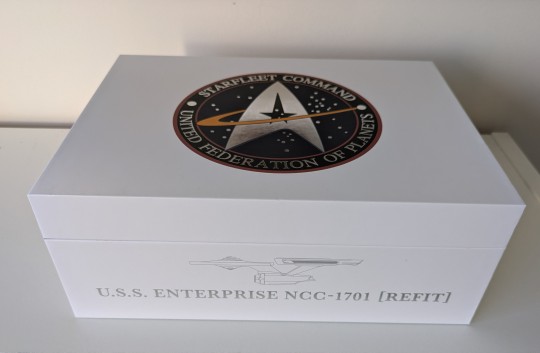
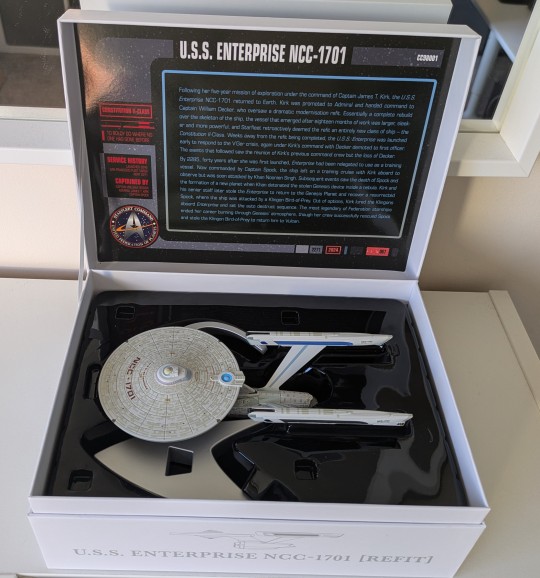
Firstly, the box feels very premium with a foil Starfleet Command logo on the top, and the ship name and line drawing on the side. It hinges open to reveal the model nestled in plastic and with some text in a suitably LCARS style inside the lid.
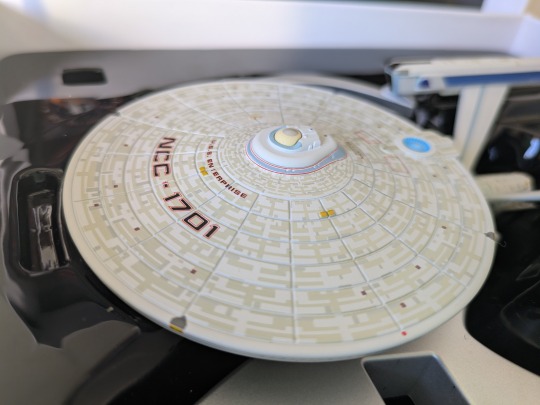
First impressions were very good! This model has some really nice fine detailing and beautifully crisp paint apps. The name and registry look spot on and are the right size. The bridge is the right shape! The saucer rim has the correct gridlines and airlocks, with the absolutely tiny name and UFP text perfectly legible.

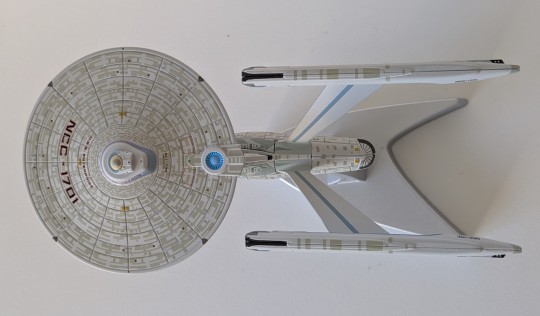
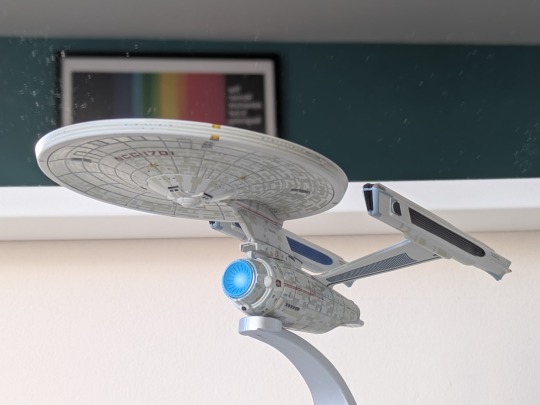
The windows are printed rather than molded so there are no alignment issues. The impulse crystal and deflector dish are painted rather than clear plastic inserts, and look excellent.
The aztec paint scheme is really nicely done. The base paint is a flat grey, with the aztec panels printed with a slight sheen. When the model catches the light it looks awesome, picking up all that detail. Really impressive for this scale.
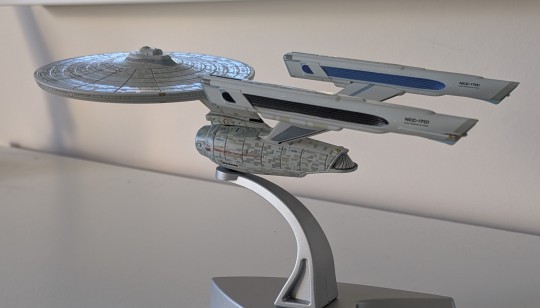
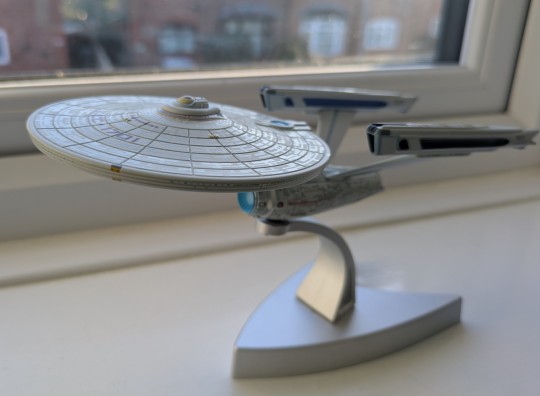
With all that being said, it is not completely flawless. The most obvious omissions are the officers' lounge windows on the rear of the B/C deck hump below the bridge, and the lack of detail on the torpedo launcher.


You can also see that the impulse engine exhaust is simply printed in flat black, and if we're being hyper critical, the rec deck windows aren't the right shape. Due to the die-cast construction, the nacelles are split down the middle, so it is missing the vertical grey detailing down the front of the intercoolers.
In terms of construction, this thing is rock solid! It appears to be entirely metal, weighing in at 245g and measuring 21cm. That's the same size as the Eaglemoss midsize ships and the new Fanhome line. However, the predominantly plastic Lower Decks USS Cerritos weighed just 180g.

The nacelles are perfectly aligned and there are no issues with parts fitting poorly. There is a small stamp for the legal info, but it is tucked away under the saucer next to a subtly embossed Corgi logo.
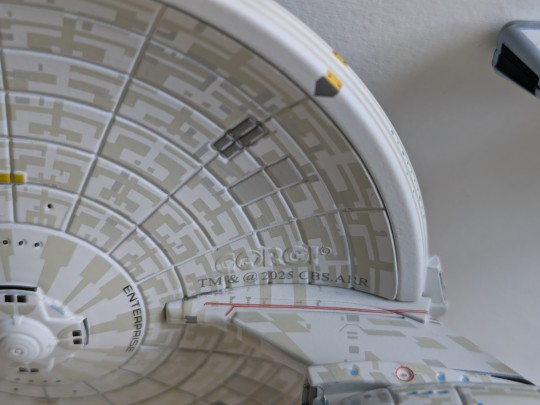

I don't love the stand. It's the same one Corgi use for their other Trek ships, and is very light plastic. The ship sits on it well enough with a rubber peg, but I don't think it would take much for it to topple over. I may look for an alternative, or perhaps fit some weight to the base.

Is it good value for money? At £64.99 it is on the pricier side, although die-cast model prices have been climbing dramatically in recent years. The slightly larger Eaglemoss XL Enterprise-A retailed for £49.99 in 2018, but the new Fanhome range now cost £55 each, and their XL models are a staggering £80! I think the Corgi model is better quality overall, so represents fair value for money. If you are a collector of die-cast Star Trek ships, I don't think you will be disappointed.
It's available now from Corgi's online shop, and presumably UK model and toy shops. Unfortunately I believe they do not have the licence to distribute in North America, so you may need to import if you want one.
1 note
·
View note
Text
SanRex CVM75BB160 Bridge Diode Rectifier
CVM75BB160 is a high-power bridge rectifier diode designed for use in high-voltage and high-current applications. It is a four-terminal device that consists of four diodes arranged in a bridge configuration. This allows the diode to convert an alternating current (AC) input signal into a direct current (DC) output signal.
The CVM75BB160 diode is housed in a compact and rugged module that is designed for easy mounting and high reliability. The module is constructed using a high-temperature, thermally conductive material that allows for efficient heat dissipation. The diode module is rated for a maximum peak reverse voltage of 1600V and a maximum average forward current of 75A.
The CVM75BB160 diode module has low forward voltage drop and low leakage current, which results in high efficiency and low power dissipation. The module also has a high surge capability, which makes it suitable for use in applications with high transient overloads. The diode module has a built-in snubber circuit that reduces voltage spikes and transients, protecting the diode from damage and increasing the module's overall reliability.
Overall, the CVM75BB160 bridge rectifier diode module is a high-performance and reliable component that is widely used in power supply, motor control, and other high-current applications. Its compact and rugged design, high surge capability, and built-in protection features make it an ideal choice for demanding industrial and commercial applications.
#Diode#Bridge Rectifier#Full Wave Bridge Rectifier#Bridge Rectifier Diode#High Current Bridge Rectifier#High Power Bridge Rectifier#SanRex CVM75BB160#SanRex Rectifier#Rectifier SanRex#CVM75BB160#Diode Module#SanRex#CVM75BB160 Datasheet#SanRex Diode Module#SanRex Distributor#SanRex Diode
0 notes
Text
A simple DIY guitar tremolo pedal
Have you ever thought of making your guitar sound differently or just livening things up a bit? In addition to reverb and chorus, a subtle tremolo can help. Today, I will build a very simple tremolo pedal using three transistors.

Of all the time-based effects, electronic tremolo is the easiest to get.
The important thing is that one does not need to alter amplifier bandwidth for tremolo, like in wah pedals and phasers, by electronically reconfiguring frequency-dependent circuits containing active and reactive resistances—resistors, coils, and capacitors.
There is no need to implement, much less modulate, the signal time delay. This is done in delays, reverbs, flangers, and choruses using mechanical, analog (bucket brigade devices, BBD), and digital delay lines.
Moreover, there is no need to process the frequency of the input signal. Raising the frequency by an octave is relatively simple; it takes a full-wave rectifier, similar to those used in power supply units.

A full-wave rectifier folds the wave. It turns the lower half-wave up, and now there is a whole period of the output signal for each half-cycle of the original signal.
We have doubled the fundamental frequency and added some harmonics. After all, the output signal is no longer sine. The upper half-wave is smooth, and the lower half-wave is pointy.
The first octave did not use a bridge rectifier with four diodes but a half-bridge rectifier with two diodes and a transformer with the winding having a midpoint.
Such a transformer was easy to find. For example, a phase-inverter matching transformer from a pocket transistor radio could do. We've put together a receiver of this kind in a post about the Regency TR-1.

It is unnecessary to use a transformer if you build a full-wave rectifier using operational amplifiers.

And finally, when making a phase inverter for a full-wave rectifier, you can do it without operational amplifiers. One transistor is enough. After all, the output signal at its emitter has the same polarity as the input signal at the base, and at the collector, it has inverted polarity.

Suppose the signal frequency needs to be decreased by half, not increased. In that case, that is, by one octave, then synchronous D-flip-flops, which we've discussed in previous articles, will be helpful.

A circuit divides the oscillator frequency on a 555 timer by 2, 4, 8, and 16. That is, by two to the first, second, third, and fourth powers. And if we speak musical terminology, we lower the tone by one, two, three, and four octaves.
However, electric guitar pickups do not produce digital pulses or even a sine wave but an analog signal of a complex shape with many harmonics. So, to divide the frequency with flip-flops, the guitar signal must be preprocessed by converting it into rectangular pulses.
One possible circuitry answer to this problem is in the diagram of this old Japanese pedal. Here, the signal on its way to the latches passes through a compressor and a Schmitt trigger.

The compressor is needed to process both loud and quiet notes effectively. Interestingly, the CMOS NAND gate circled in green on the diagram, is used as an analog signal amplifier.
This is doable. The ratio of the resistor value between the output and the inverting input of the CMOS inverter to the impedance in series with the input determines the gain, just like in an operational amplifier.
An excellent example of a pedal that uses CMOS inverters rather than transistors, op-amps, or tubes to amplify the guitar signal is the Tube Sound Fuzz circuit, designed by Craig Anderton and published in his 1975 book "Electronic Projects for Musicians."

Frequency dividers on flip-flops work well with a single note. And for a chord or pitch shifting at an interval of a non-integer octave number, a digital signal processor is almost always required.
Perhaps the only exception is the perfect fifth. The original frequency must be divided by three and multiplied by two to obtain it. Frequency division into three is possible using a single CD4013 chip containing two synchronous D-flip-flops with asynchronous setup and reset.

At each of the points of the circuit, marked with numbers 2, 3, and 4, there is a frequency from point 1, divided by 3, in the form of a PWM signal with a duty cycle of 2/3 or 1/3. For music, this sounds even better than a duty cycle of 1/2.
The phases of the signals at these points are shifted between each other, which can also be used for interesting sound effects. But there is one problem.
Modern music uses not natural but evenly tempered tuning. Therefore, our electronic fifth, played by flip-flops, will be slightly out of tune relative to the fifth on the guitar frets.
The frequency of this equal-tempered fifth is not equal to two-thirds the frequency of the original note but to the frequency of the original note divided by the 12th root of 128. This system allows one to freely transpose melodies and chord progressions from one key to another. That is why it became universally recognized.
And to get a tremolo, you don’t need all these tricks. Two functional blocks are enough: LFO and VCA, a low-frequency oscillator, and a voltage controller amplifier.
Each of them can be implemented literally on one transistor. This is precisely what the developers of the Univox/Unicord U65RN combo amplifier, produced since 1971, did.

Frequency dividers on flip-flops work well with a single note. And for a chord or pitch shifting at an interval of a non-integer octave number, a digital signal processor is almost always required.
Perhaps the only exception is the perfect fifth. The original frequency must be divided by three and multiplied by two to obtain it. Frequency division into three is possible using a single CD4013 chip containing two synchronous D-flip-flops with asynchronous setup and reset.

At each of the points of the circuit, marked with numbers 2, 3, and 4, there is a frequency from point 1, divided by 3, in the form of a PWM signal with a duty cycle of 2/3 or 1/3. For music, this sounds even better than a duty cycle of 1/2.
The phases of the signals at these points are shifted between each other, which can also be used for interesting sound effects. But there is one problem.
Modern music uses not natural but evenly tempered tuning. Therefore, our electronic fifth, played by flip-flops, will be slightly out of tune relative to the fifth on the guitar frets.
The frequency of this equal-tempered fifth is not equal to two-thirds the frequency of the original note but to the frequency of the original note divided by the 12th root of 128. This system allows one to freely transpose melodies and chord progressions from one key to another. That is why it became universally recognized.
And to get a tremolo, you don’t need all these tricks. Two functional blocks are enough: LFO and VCA, a low-frequency oscillator, and a voltage controller amplifier.
Each of them can be implemented literally on one transistor. This is precisely what the developers of the Univox/Unicord U65RN combo amplifier, produced since 1971, did.
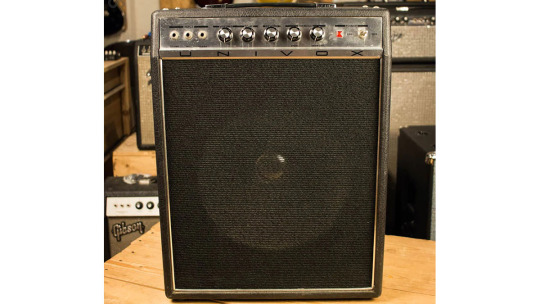
It had 15 watts of power, a 12-inch loudspeaker, and a spring reverb. It was assembled according to a relatively simple circuit by today's standards. However, at that time, it was considered quite complex.

Our attention should be drawn to the lower left corner, which shows the tremolo diagram. The leftmost transistor is used in the phase-shifting RC LFO. This generator produces harmonic sine waves, the frequency of which is controlled by the SPEED potentiometer.
Oscillations from the LFO output go to the modulation intensity control INT and to the second transistor's base. This transistor simply bypasses all input signals from the microphone, guitar, and organ. This is how the VCA is made.
And the tremolo pedal jack simply shorts the LFO signal to the ground, and the VCA transistor is completely turned off. This allows one to turn the tremolo on and off using a pedal with just a latching SPST button inside.
The diagram published by Anthony Leo in the November 1968 issue of Electronic Australia Magazine, 3 years before the Univox/Unicord U65RN, differs slightly from the tremolo found in this combo amp.
Since then, the circuit has been called the Electronic Australia tremolo or EA tremolo for short. It's a beloved one among pedal enthusiasts.

Here, the VCA comprises a common-emitter bipolar transistor Q1 and a JFET Q2 that bypasses most of Q1's AC bias resistance, thereby modulating the stage's gain.
I've assembled this DIY pedal kit from Landtone using just this scheme. In the video below, you can hear the resulting sound.
Due to such an exciting circuit design, the effect turned out to be very beautiful. This is the best tremolo I have ever encountered.
As we can see and hear with our own eyes and ears, excellent results can be achieved using simple means if you approach the project thoughtfully and with love.
0 notes
Text
Three Phase - Bridge Rectifier Module – Insel Rectifiers
Welcome to Insel Rectifiers – Your go-to for top-notch Three-Phase Rectifiers. We excel in crafting efficient Three-Phase Bridge, Diode Bridge, and Full Wave Rectifiers. Our commitment to excellence is evident in industry-leading craftsmanship, ensuring reliability and adherence to rigorous standards. Choose Insel for unmatched expertise, quality assurance, and a customer-centric approach. Elevate your systems with us – where quality meets innovation!.
0 notes
Text
Main usages and applications of aluminium PCB board:
Audio devices: input, output amplifiers, balanced amplifiers, audio amplifier, preamplifier, power amplifier etc.
Power Supply: switching regulator, DC / AC converter, SW regulator .
Telecommunications electronic equipment: high-frequency electric amplifiers, filtering appliance, transmitter circuit etc .
Office automation equipment: electric motor, drivers etc .
Automotive: electronic regulator, ignition, power controllers etc .
Computer: CPU board, floppy drive, power device etc .
Power Modules: converter, solid-state relay, power rectifier bridges etc .
Lamps Lighting: with the promotion of energy-saving lamps, Aluminum base PCB , are widely used on LED lights.
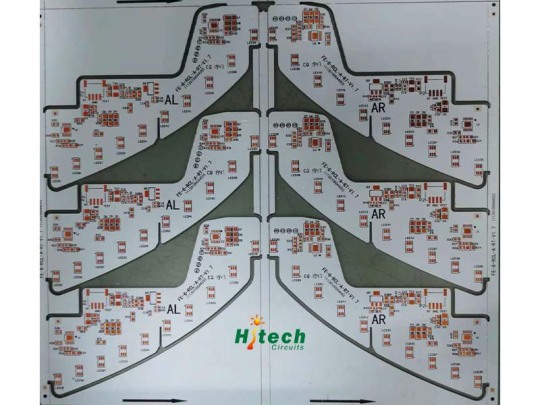
0 notes
Text
Global Bridge Rectifier Modules Industry Chain Analysis Report 2025
Global Info Research announces the release of the report “Global Bridge Rectifier Modules Market 2025 by Manufacturers, Regions, Type and Application, Forecast to 2031”. This report provides a detailed overview of the Bridge Rectifier Modules market scenario, including a thorough analysis of the Bridge Rectifier Modulesmarket size, sales quantity, average price, revenue, gross margin and market share.The Bridge Rectifier Modulesreport provides an in-depth analysis of the competitive landscape, manufacturer’s profiles, regional and national market dynamics, and the opportunities and challenge that the market may be exposed to in the near future. Global Bridge Rectifier Modules market research report is a comprehensive analysis of the current market trends, future prospects, and other pivotal factors that drive the market.
According to our (Global Info Research) latest study, the global Bridge Rectifier Modules market size was valued at US$ 13.4 million in 2024 and is forecast to a readjusted size of USD 19.4 million by 2031 with a CAGR of 5.5% during review period.
Market Segmentation Bridge Rectifier Modules market is split by Type and by Application. For the period 2020-2031, the growth among segments provides accurate calculations and forecasts for consumption value by Type, and by Application in terms of volume and value. Market segment by Type: Single Phase Rectifier Bridges Modules、Three Phase Rectifier Bridges Modules Market segment by Application: Inverter、Inductive Heating、Chopper Major players covered: Semikron Danfoss、Infineon Technologies、Littelfuse (IXYS)、MacMic Science & Technology、Yangzhou Yangjie Electronic Technology
The content of the study subjects, includes a total of 15 chapters Chapter 1, to describe Bridge Rectifier Modules product scope, market overview, market estimation caveats and base year. Chapter 2, to profile the top manufacturers of Bridge Rectifier Modules, with price, sales, revenue and global market share of Bridge Rectifier Modules from 2020 to 2025. Chapter 3, the Bridge Rectifier Modules competitive situation, sales quantity, revenue and global market share of top manufacturers are analyzed emphatically by landscape contrast. Chapter 4, the Bridge Rectifier Modules breakdown data are shown at the regional level, to show the sales quantity, consumption value and growth by regions, from 2020 to 2031. Chapter 5 and 6, to segment the sales by Type and application, with sales market share and growth rate by type, application, from 2020 to 2031. Chapter 7, 8, 9, 10 and 11, to break the sales data at the country level, with sales quantity, consumption value and market share for key countries in the world, from 2020 to 2025.and Bridge Rectifier Modules market forecast, by regions, type and application, with sales and revenue, from 2025 to 2031. Chapter 12, market dynamics, drivers, restraints, trends and Porters Five Forces analysis. Chapter 13, the key raw materials and key suppliers, and industry chain of Bridge Rectifier Modules. Chapter 14 and 15, to describe Bridge Rectifier Modules sales channel, distributors, customers, research findings and conclusion.
Our Market Research Advantages Global Perspective: Our research team has a strong understanding of the company in the global Bridge Rectifier Modules market. and offers pragmatic data to the company. Aim And Strategy: Accelerate your business integration, provide professional market strategic plans, and promote the rapid development of enterprises. Innovative Analytics: We have the most comprehensive database of resources, provide the largest market segments and business information.
About Us Global Info Research is a company that digs deep into global industry information to support enterprises with market strategies and in-depth market development analysis reports. We provide market information consulting services in the global region to support enterprise strategic planning and official information reporting, and focuses on customized research, management consulting, IPO consulting, industry chain research, database and top industry services. At the same time, Global Info Research is also a report publisher, a customer and an interest-based suppliers, and is trusted by more than 30,000 companies around the world. We will always carry out all aspects of our business with excellent expertise and experience.
0 notes
Text
Low Harmonic Drives: Driving Towards a Greener Future How Clean Power is Empowering the Automotive Industry
Over the past few decades, variable frequency drives (VFDs) have become widespread in industrial and commercial applications for their ability to control motor speed and torque. Traditionally, VFDs utilize pulse width modulation (PWM) techniques to vary motor voltage and frequency. However, PWM generates high harmonic currents that can damage motors, heat up transformers and power cables, and potentially cause voltage distortions on the utility grid. To address these challenges, a new generation of low harmonic drives has emerged based on advanced switching algorithms. What are Harmonics? In electrical systems, harmonics refer to sinusoidal voltages or currents having frequencies that are integer multiples of the fundamental power supply frequency, usually 50 or 60 Hz. Harmonics are produced by non-linear loads like adjustable speed drives that draw non-sinusoidal currents from the power source. The extra frequencies generated interact with the system impedance and generate losses, heating, vibrations, torque pulsations and can even cause misoperation of protective devices if sufficiently high in magnitude. Harmonics cause additional power losses in distribution transformers and overvoltages that reduce insulation lifetime. They can also interfere with communication lines. Traditional PWM Drives and their Harmonic Impact Traditional PWM VFDs employ insulated-gate bipolar transistors (IGBTs) or thyristors to rapidly switch the motor voltages on and off, generating quasi-square wave voltages to control motor speed. However, when these non-sinusoidal voltages are applied to the motor windings, they produce harmonic currents in the supply lines that are integer multiples of the fundamental supply frequency. Specifically, PWM drive techniques generate dominant 5th and 7th order harmonics that can propagate back into the utility system if not properly filtered. The harmonic currents not only stress motor windings but also increase I2R losses in the supply feeders and distribution transformers. Low Harmonic Drives can cause overheating in older transformers not designed for harmonics. Harmonic distortions also increase circulating currents within delta-wye grounded transformers. To mitigate these issues, dedicated harmonic filters need to be installed, increasing overall system costs. Excessive harmonics if left unchecked can even cause protective relays to malfunction. Advancements in Low Harmonic Drive Technology To address harmonic pollution from VFDs, innovative drive manufacturers have developed new low harmonic drive technologies based on advanced switching algorithms that naturally minimize the generation of lower order harmonics. Pulse-Density Modulation
One such technique is pulse density modulation (PDM) where the IGBTs are switched at high frequencies using narrower pulses compared to traditional square waves. By spacing the pulses closer together over time, PDM produces quasi-sinusoidal drive output voltages that inherently contain lower harmonics. PDM drives generate less than 5% total harmonic distortion (THD) without additional filters. Active Front End Drives
Another option is active front end (AFE) drives with a front-end rectifier consisting of IGBTs or MOSFETs instead of diode bridges. The AFE rectifier actively shapes the supply current waveform to follow the voltage waveform and provide near unity power factor without harmonics. AFE drives come with integrated DC chokes to absorb any remaining higher order harmonics internally, keeping them well below 5% THD.
Get more insights on Low Harmonic Drives
Also read related article on Ransomware Protection Market
Unlock More Insights—Explore the Report in the Language You Prefer
French
German
Italian
Russian
Japanese
Chinese
Korean
Portuguese
Alice Mutum is a seasoned senior content editor at Coherent Market Insights, leveraging extensive expertise gained from her previous role as a content writer. With seven years in content development, Alice masterfully employs SEO best practices and cutting-edge digital marketing strategies to craft high-ranking, impactful content. As an editor, she meticulously ensures flawless grammar and punctuation, precise data accuracy, and perfect alignment with audience needs in every research report. Alice's dedication to excellence and her strategic approach to content make her an invaluable asset in the world of market insights.
(LinkedIn: www.linkedin.com/in/alice-mutum-3b247b137 )

#Low Harmonic Drives#Harmonic Mitigation#Low Harmonic VFD#Variable Frequency Drives#Harmonic Distortion Reduction#Energy-Efficient Drives#Harmonic Filters
0 notes